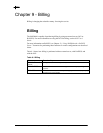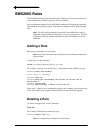
Service Creation Using Groups and Rules
TUT Systems, Inc Page 66 of 104 P/N 220-06288-20
VLAN
When using a VLAN switch as a wiring solution, each VLAN effectively is treated as a
“room,” similar to the “snmp-info” used with Tut Systems equipment (e.g., an MDU Lite
or Expresso GS/MDU Chassis).
Managers can write rules that affect one or many VLANs:
vlan=
vlanida[-vlanidb]
Where
vlanida is a VLAN ID expressed as an integer greater than 1.
vlanidb is an optional VLAN ID expressed as an integer greater than vlanida.
For example:
vlan=42 matches any computer connected through a VLAN switch on a port assigned to
VLAN id 42.
vlan=293-400 matches any computer connected through one or more VLAN switches on
any port assigned to VLAN id 293, 294, 295 ... 398, 399, 400.
SNMP-INFO
When using an Expresso GS/MDU Chassis or MDU Lite (LR or HR) as a wiring
solution, managers can write rules that apply to users based on their port, or to a set of
users on a set of ports.
tut=
ip_address-linenum|*-portnum|*
For example:
“tut=123.123.123.123-001-001” affects any user on slot 1 line 1 of an Expresso GS/MDU
Chassis or MDU Lite at IP 123.123.123.123. That device must be in the snmp-poll
configuration of the SMS2000.
“tut=123.123.123.123-002-*” affects all users on slot 2 (any line) of an Expresso
GS/MDU Chassis or MDU Lite at IP 123.123.123.123.
“tut=123.123.123.124-*-*” affects all users on all slots on all lines of an Expresso
GS/MDU Chassis at IP 123.123.123.124.
The NOT Operator
The “NOT” operator is used to negate the subsequent expression. In other words, the rule
applies if the subsequent expression is not true.
not expression
For example:


















